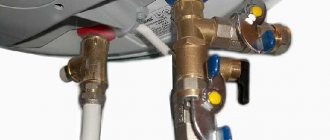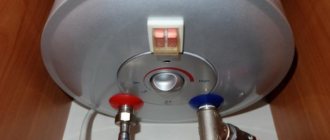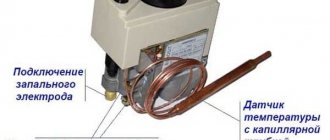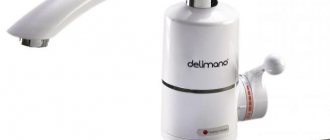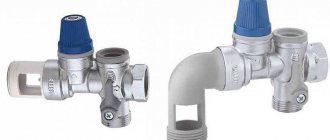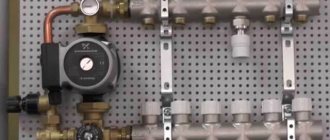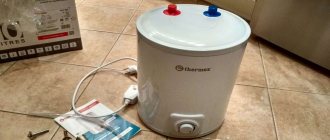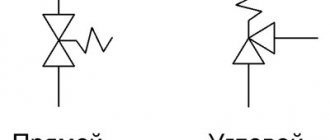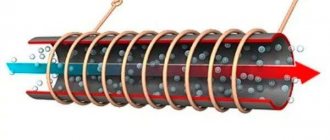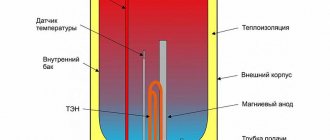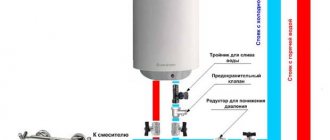Boilers ensure independence from public utilities, supplying people with water around the clock and at any time of the year. If the safety valve is dripping in the water heater, this circumstance should be considered objectively, without nerves or showing emotions. First of all, you need to understand that the faucet is designed for water to drip from it. The only question is how often this happens and what volumes of liquid leave the tank per unit of time. A calm analysis of this phenomenon will allow you to understand the nature of its origin and take effective measures to eliminate the malfunction.
Main functions of a safety valve
The safety valve protects the device from excess pressure and water hammer.
The first water heaters went on sale without components; the packaging of modern products always contains a safety valve. The instructions for installing and operating the tank state that operating the boiler without this part is strictly prohibited. The manufacturer indicates the location and method of attaching the valve. This recommendation is justified by the fact that tanks have a limited safety margin, and excessive internal pressure can simply rupture them. This situation is extremely dangerous for the life and health of people and can cause large-scale flooding of several apartments in a multi-story building.
Main functions of a check valve:
- Discharge of water from the tank when, when heated, it expands and begins to press on its walls with a force greater than that provided by the calculated data. Depending on the pressure level, water may run or drip at different rates.
- Compensation for water hammer. During such phenomena, the water pressure increases to values that are critical for domestic boilers. Thanks to a well-designed emergency mechanism, the faucet reduces the pressure by releasing liquid through a special pipe.
Most often, water drips from the boiler through the valve at night, when the volume of its consumption decreases significantly, but the pressure remains the same. The sound of falling drops may annoy household members, but this is not the worst thing. The main thing is that the emergency valves are working properly and people are not in danger. You can easily get rid of the noise - just tie a bandage, rope or long piece of fabric to the pipe and take it out into the bathtub, sink or toilet. Subsequently, the material should be replaced with an elastic drainage tube.
Principle of operation
If there is excess pressure, water is discharged into the sewer through the supplied pipe.
The check valve is a direct-acting safety pipeline fitting designed to protect water heating equipment from mechanical destruction under the influence of critical pressure. The principle of operation is to automatically adjust the water pressure inside the boiler. When it reaches the limit values, water is discharged. Release is carried out until the pressure reaches operating values.
The accuracy and functionality of the safety valve is determined by the parameters and settings of the internal parts.
Is it dripping or flowing?
If water drips from the check valve device during the heating of the boiler equipment, then this situation indicates the normal functioning of the device and the operation of the protective group in normal mode.
During operation of a water heating device, the safety valve must discharge excess liquid if there is an increase in water pressure on the walls of the storage tank as a result of thermal expansion of the liquid. The consequence of water discharge is a noticeable decrease in water pressure inside the tank with heating elements.
Installation diagram of a safety valve for a boiler
To monitor the process of removing excess water, it is necessary to install a regular transparent reinforced plastic pipe on the outlet fitting, the outlet of which is mounted on the sewer system.
The water should not flow in a stream, and the release of droplets should stop immediately after cooling.
If water drips constantly, the problem may be a malfunction of the safety valve device or the liquid is drained due to a worn rubber or silicone seal..
It is imperative to take into account the fact that not all devices are characterized by the presence of a drain for water from boiler equipment, therefore, if necessary, a standard tee tap must be installed.
Types and design of valves
According to their design, products are divided into monolithic and collapsible. The first are a monoblock, inside of which parts are pressed. The second option is equipped with a hole through which, after unscrewing the lid, access to the inside of the product is possible. The valves also differ in the way they drain drainage. Some have drops falling from a protruding pipe, others are equipped with a closed piping system with outlet to the sewer.
Structure of safety valves
General arrangement of safety valves:
- Frame. It has internal and external fastening threads and a side pipe. Made from steel or brass. Can be plated with nickel, chromium or zinc.
- Big cylinder. Located at the bottom of the body. Opens when opening the mixer and to fill the tank. It closes after the pressure inside the container and in the water supply system is equalized. Prevents water from flowing back into the supply pipe.
- Small cylinder. Located in the middle of the product, it is equipped with a more powerful spring. It contracts when the water pressure in the boiler or water supply exceeds the established norm. The drainage hole is released, through which the liquid flows out.
High-quality products from leading manufacturers have clear markings made using the molding method during the casting process. There are no visible seams or other defects. Branded parts are accompanied by a certificate of conformity. The price of such a product can reach up to 1000 rubles, but the safety is worth it.
Device
The safety valve consists of the following elements:
- Frame. The material used is steel or brass. The protective coating is made of nickel, chromium and zinc. There is a mounting thread on both sides of the housing (one internal and the other external). The side pipe has a fitting for draining water;
- Big cylinder. Located in the main body, it is triggered when water is supplied from the water supply system while the water heater tank is filling;
- Small cylinder. It is located in the side pipe, equipped with a spring of calculated power and is triggered by a certain pressure value in the tank.
Safety valve disassembled
When choosing a high-quality device, you need to pay attention to the outer casing; it should not show clearly visible seams, casting residues, other defects and traces of additional processing. There is a marking on the body of the safety valve for the boiler, as well as an arrow indicating the direction of water supply. All markings must be made clearly using the casting method, which is carried out simultaneously with the production of the product. The valve on the side pipe should move tightly, with a slight click when locked in the open position. Estimated price from 500 to 1,000 rubles. Products from branded manufacturers have a passport indicating the main parameters, primarily working pressure, and/or a quality certificate.
Valve installation and adjustment
The safety valve is mounted on the cold water pipe.
The check valve is attached to the cold water pipe. For ease of work, manufacturers mark it in blue. You can screw the tap on at any stage of installation, but it is more advisable to do this before hanging the tank on the hooks. When the heater is on the floor, working with it is much easier, more convenient and safer.
Installation should be done in the following sequence:
- Unscrew the mounting bolts and remove the plastic cover. To prevent it from interfering with your work, you do not need to remove the light bulb from it and then put it in a safe place.
- Inspect the threads on the inlet pipe of the tank, visually check its integrity. Clean the coils with a brush and remove transport grease with a dry cloth.
- Carry out a similar procedure with the upper union nut of the valve. If there are burrs, they must be carefully removed with a knife or file.
- Wrap tape around the FUM pipe. This should be done clockwise, moving the thickening towards the side. The layer thickness should be 1 mm at the cut and 3 mm at the beginning of the thread.
- Take the valve, catch the edge of the thread and start screwing it on. The product should go tightly and with effort. It is important that at the end of the rotation the nut does not rest against the side. This will mean that not enough FUM tape has been wound. The procedure will have to be repeated.
After fixing the safety valve, you can immediately attach the ball valve to it. The procedure is similar.
Why is the safety valve on the water heater dripping?
The following story often happens - a person, as a result of another hot water outage, decides to buy a storage water heater in order to save himself from the pain of heating water in a kettle.
And lo and behold! The water heater was purchased, installed and working. And suddenly the joy of buying a valuable household appliance is overshadowed by the fact that water begins to drip from the safety valve... What is the cause of this disaster on the scale of one bathroom?? Valve leaks can be eliminated using two methods:
Method No. 1
The safety valve simultaneously performs three functions - it is simultaneously a return valve, an emergency valve and a bypass valve! First, when the pressure increases, it releases water back into the water supply system (works as a bypass), and then, if there is not enough volume, it dumps the water on the floor (works as an emergency). To prevent water from dripping onto the floor, you need to find its volume inside your water supply. This can be done either by installing a small expansion tank (which does not look very aesthetically pleasing), or you can drill through the check valve membrane on the cold water meter. Of course, your management company will not like the second option and you will have to break the seal on the meter, but if by some miracle you can do this, then I advise you this option! It will stop dripping and there is no need to put anything extra in the bathroom.
you need to drill out the check valve diaphragm.
Method No. 2
This method involves draining water from the valve into the drain or into the toilet cistern. To do this, you will need to find a soft tube of such a diameter that it can be put on the fitting on the valve from which water is dripping. Personally, I did exactly this at home! I took a flexible tube from a construction hydraulic level and carried water through it into the sewer. This is much simpler and cheaper than buying and installing an expansion tank, but drilling a check valve was impossible for me - I didn’t want to break the seal on the meter. I'll explain what I did using the photos below.
drain pipe on the safety valve.
Inserting a drainage tube into the sewer.
After installing the drainage, all the water that the valve discharges will no longer drip onto the floor and create inconvenience for you. The drainage inlet into the sewer is sealed with plumbing sealant and that’s the end of it! This method works great. It can also be used for hidden installation of a water heater , when the tank is hidden in a niche and covered with plasterboard on top.
That's all for today, I'm waiting for your comments and questions
If you do not limit the heating of water in the boiler, it will boil and turn into steam, which will lead to a critical increase in pressure in the heating network. This is followed by a rupture of the pipeline or water jacket of the heat generator. To avoid the described emergency situation, a safety valve for heating is installed at the boiler outlet, releasing excess pressure from the system. Our publication is devoted to the selection and installation of this important element.
Causes of safety valve failure
With constant high pressure, the spring inside weakens, the part needs to be replaced.
If the valve on the boiler drips constantly, regardless of the time of day and the intensity of water use in the house, there is a high probability that the product is faulty. There can be many reasons for this.
- Manufacturing defects. As a rule, these are weak springs and leaky cylinders. Such products will operate even under operating pressure. Those who are trying to save money and buy cheap Chinese counterfeits have to deal with such a nuisance.
- Blockage. Occurs when the tank is not cleaned properly or due to poor water quality. The essence of the breakdown is that after compression, the spring cannot expand, since solid particles form an obstacle in its path. With such a malfunction, the product will leak even when the device is turned off and the tap is closed.
- High system pressure. This is not uncommon on the top floors of high-rise buildings with overhead water supply. Since the pressure is maintained at a constantly high level, the valve will leak continuously, regardless of the time of day.
- Mechanical damage. Occurs during transportation or during installation. Internal parts can also be damaged during cleaning - deformation of the spring, rupture of gaskets. When dropped, a gap appears at the point where the pipe enters the boiler body.
- Storage tank leaking. In such cases, there is water on the outside of the product, but it may appear that the valve on the water heater is leaking. The cause of leakage is corrosion or a broken seam.
- The top part is leaking. There is a weak connection. This is one of the most common causes of dripping on the valve. In most cases, this occurs due to a hardened gasket under the nut or insufficient amount of FUM tape.
- Wear of springs. Over time, they lose their elasticity and begin to shrink even with slight pressure. Nothing will help here. All that remains is to install a temporary drain and go to the store for a new valve.
Once a leak has formed, it will not go away on its own. The situation will only get worse until it reaches a critical state. Therefore, if the safety valve on the boiler is leaking, it is necessary to take urgent measures to determine the causes of this phenomenon and restore the functionality of the water heater.
Several reasons why water is leaking from the water heater valve
Water heater valve failure
The list is small, but each item requires careful consideration.
- The first thing that comes to mind is a breakdown of the valve itself. Here you should immediately make a reservation that if you have purchased a part from a dubious manufacturer, then this option is quite possible. High-quality valves installed in a branded water heater rarely suffer from such defects. This is because it is so simply designed that there is nothing to break. Intake valve, spring and check valve. That's it, there's nothing else there. Chinese products are made if basic standards are not observed and may become unusable.
- But even high-quality valves from a reputable manufacturer can become clogged. And again, not on their own. This usually happens after all the water in the water heater has been drained through it. Then pieces of scale or other foreign particles may get into it, which will prevent the spring from tightly closing the valve, which leads to constant leakage.
- The initial stage of work involves releasing water from the boilers. The same laws of physics apply here. Cold water enters the tank and the pressure is equalized. Then the water begins to heat up, as a result of which it expands and its excess flows out of the safety valve.
- Sometimes the safety valve for the water heater leaks due to high pressure in the water supply system. Here, as you might guess, neither the valve nor, especially the boiler, is absolutely to blame. Moreover, they efficiently fulfill their purpose, releasing excess pressure in a timely manner. Well, this reason will have to be eliminated in other ways, without touching the water heater at all.
As you can see, half of the reasons why a boiler valve leaks have nothing directly to do with it. That is why it is important to determine why the water is flowing, and not to deal with water heating devices by dismantling them, disassembling them for spare parts or calling repair specialists.
Night concerts from the valve
Probably, it was not worth highlighting this reason why water flows from the valve, but sometimes it can really scare you, and not only because you will have to carry out repair work or spend money on calling a specialist.
Night leaks of the safety valve can be accompanied by rather unpleasant and loud accompanying sounds, which, you see, is not very convenient when the whole family wants to sleep.
But it is almost impossible to eliminate such a malfunction directly within a few minutes, because it is not your water heater that is to blame.
The fact is that water utilities either do not consider it necessary, or are simply too lazy, to monitor the difference between daytime and nighttime water consumption. As a result, it turns out that the pressure in the system is the same, but the water intake is several times less, which leads to the activation of the safety valve in your boiler, and sometimes an emergency one. Hence all these nightly, albeit short-lived, concerts.
Repair work
To diagnose and fix the breakdown, you will need to stock up on a set of tools and some consumables.
To work you will need:
- adjustable wrench, plumbing pliers, screwdriver;
- scissors;
- awl;
- indicator;
- FUM tape or tow;
- flexible hoses for easy draining of water from the tank;
- lemon acid;
- box for collecting small parts;
- rags.
Measures should be taken to protect limbs and vision. It is better to carry out repairs wearing protective glasses and gloves.
Valve repair is usually combined with scheduled boiler cleaning, so as not to waste time disassembling the device
First you need to make sure that the cause of the leak is the check valve. It is enough to check whether its body is dry or not. If there is no moisture on it, then you need to start disassembling. This event can be timed to coincide with cleaning the heater and the tank from scale. In any case, the effort will not be wasted.
Dismantling should be carried out in the following sequence:
- Turn off the water. If a walk-through tap is installed in front of the mixer, it is better to turn it so as not to turn off the entire apartment.
- Disconnect the device from electricity. Remove the cover and disconnect the wires from the terminals.
- Unscrew the underwater pipes from the boiler. Remove the ball valve and safety valve.
- Screw flexible hoses to the nozzles, the water will flow in the desired direction.
- If there is a pressure gauge, check the operating water pressure. Ideally, it should be 1.5-2 atm.
- While the liquid is draining, remove any remaining FUM tape and inspect the parts for cracks and dents.
- Clean the tank and heating element from limescale and scale. Rinse the inside of the container using a shower head.
The removed check valve must first be washed under running water to remove scaly fragments. After this, the product should be immersed in a container with a solution prepared from water and citric acid in a ratio of 10:1. You can speed up the cleaning process by boiling. 10-15 minutes are enough for the valve to become like new. All that remains is to treat it with silicone grease and you can put it back.
Leaking when the boiler is off
Let's simulate the following situation: the water heater is disconnected from the network, the water supply from the water supply is turned on (the tap on the pressure line is open). Water is flowing from the boiler drain hole. The cause of this phenomenon may be either a malfunction of the safety valve or increased pressure in the line.
To find the cause of a leaking safety valve, you need to know the water pressure in the water supply
To determine the culprit of the leak, you need to measure the cold water pressure in the water supply. The fact is that if the main pressure exceeds the accepted SNiP, the valve will open and perform its functions of discharging excess water into the sewer. Most water heater safety valves that manufacturers equip their products with are set to a pressure of 6 to 8 atmospheres. The maximum pressure allowed by SNiP in main water pipelines should not exceed 6 atmospheres. In fact, it often happens that actual indicators exceed standard values by 1 - 2 atmospheres. Naturally, the safety mechanism will work.
The second cause of leaks may be the valve itself. Wear of its plate or seat, weakening of the spring - these are the factors that can lead to leaks. Cheap Chinese products are often susceptible to such malfunctions.
The possibility of particles of scale or debris getting under the locking mechanism plate, which can happen during an emergency pressure release or after draining water from the boiler during maintenance or repair work, cannot be discounted.
If the safety valve leaks, do not under any circumstances remove this part from the water supply system to the water heater. Remember that operating a storage water heater without a safety valve is prohibited and can lead to its explosion.
Extending the service life of the boiler
The main enemies of the boiler and check valve are impurities in the water and increased pressure in the pipeline. These problems are solved by installing an input main magnesium filter and a special gearbox. If this cannot be done, depending on the degree of water hardness, you need to carry out preventive cleaning of the boiler and its servicing fittings every 3-9 months.
In order to prevent strong expansion of the water in the tank, it is recommended to heat it to a temperature no higher than + 55ºС.
What to do if problems are detected
Let's go in order.
- If the valve was of poor quality and the reason for its leakage was a breakdown, there is only one way out - replace it.
- If the reason is a blockage, then, of course, you can dismantle, disassemble and clean. But is it worth it? A new valve can be bought at any specialty store, and they are very inexpensive. When purchasing, you should pay attention to the country of origin, find out from the seller or read in the passport what maximum pressure it is designed for, and under no circumstances save money by buying cheap Chinese analogues. Moreover, the price of a branded valve rarely exceeds 1000 rubles.
- If water drips, as indicated, and there is no need to troubleshoot, but its sound bothers someone, and the system is not equipped with a drainage pipe, it is quite possible to install it yourself.
- If the reason is increased pressure in the pipeline, then you should not expect mercy from the water utility. A pressure reducer should be installed. And not in front of the boiler itself, but at the entrance of the system to the apartment.
The presence of hot water in an apartment or house is not only cleanliness, but also comfort. Water heating devices will be able to provide access to it at any time of the day or night, regardless of the time of year. But it’s up to the owner to keep an eye on them. Moreover, they do not require increased attention. Turn it on correctly, turn it off correctly and pay attention to possible problems in time.
Owners who have installed a storage water heater in their home often have questions about the operation of its safety valve. Is water leaking from this device normal or a breakdown? And if the water circulation must take place, then in what quantities and how often? We have already considered the design and principle of operation of a safety valve for a boiler. Now we will tell you how to determine the malfunction of this device and how to solve the problem of its leakage.
Water dripping at night
It is very important to distinguish between natural water discharge and failure of components. When the water heating equipment is connected to the electrical network, and in the absence of its operation, a small amount of it should flow through the fitting part of the valve device, including at night.
When the appliance operates in an average load mode, including regular washing of dishes and cooking, water flows out of the valve device periodically, in a volume slightly higher than the usual amount. Constant leakage, including at night, may indicate device failure.
Water is leaking from the boiler
The main reason for dripping water at night is that the fitting or the inside of the fitting is clogged with scale or debris. The spring mechanism that opens the valve is not able to close it at the right time, so water flows out even when the water heating equipment is turned off. An equally common cause of water leakage at night is too high pressure in the water supply system. In order to check the working water pressure, it is measured in the main water supply.
How much water should the valve drain?
A small amount of water should be dripped from the valve device. The total volume of liquid removed directly depends on the pressure level in the water supply system, as well as the temperature regime used for heating and the volume of the water heating equipment tank. On average, the amount of water released can be about 1.5-3.0% per day.
There are several ways to drain water from a water heater. For detailed instructions, see our website.
Read all about the pros and cons of hygienic showers for toilets here.
You will find options for finishing a bathroom with plastic panels in this topic.
